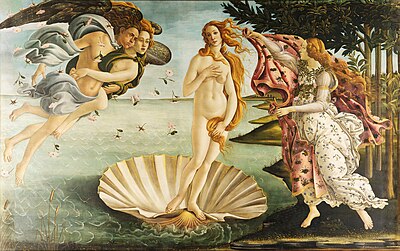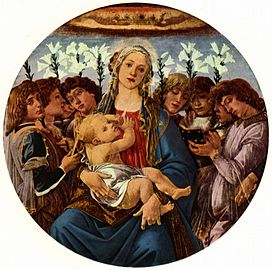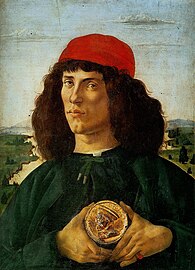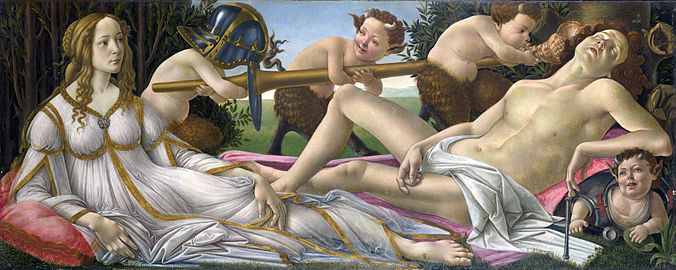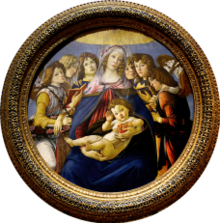Sandro Botticelli

Sandro Botticelli (born March 1, 1445 in Florence ; † 1510 , buried there on May 17, 1510 ; also Alessandro di Mariano Filipepi or Sandro di Mariano di Vanni Filipepi, called Botticelli ) was one of the most important Italian painters and draftsmen of the early Renaissance .
In the spirit of the early Renaissance and humanism Botticelli painted, influenced by Filippo Lippi , Masaccio and Antonio Pollaiuolo , devotional paintings , altarpieces and pictures from the theme of Greek mythology and allegories with contemporary relevance. Of outstanding importance is his portraiture, which has had a lasting impact on the image of the Medici and their partisans. His late work bears emotionally expressive traits with reference to the Gothic . Some elements of his painting were later taken up again by the Pre-Raphaelites in the 19th century. Even the Art Nouveau made in line and ornament bonds with him.
Live and act
Origin and education
One of the first sources about Botticelli's life comes from Giorgio Vasari's collection of biographies from 1550 (new edition: 1568), the truth of which is, however, questioned. After that, "Botticelli" was - the nickname (from botti cello "kegs") comes from his brother Giovanni - Florentine working class neighborhood Ognissanti, the youngest son of the tanner Mariano di Vanni Filipepi born. He remained connected to this city all his life. Vasari attested to his lack of diligence in school; he was always restless there and never satisfied with any class. His father apprenticed him to a goldsmith; on this a penchant for extravagant jewelry was probably based in his later portraits of women.
From 1464 he became a student of the Prato workshop of the then most famous painter in the city, Fra Filippo Lippi (1406–1469), for three years . Florence remained his spiritual home throughout his life, where he received strong artistic stimuli from humanism, which was particularly encouraged in the Florentine aristocratic circles.
Between 1465 and 1470 Botticelli made a number of pictures of the Madonna, including the Madonna with Child and Two Angels , made between 1468 and 1469. These early works clearly show the influences of his master Lippi, but also the more robust style of the two leading painters at the time Florence, Antonio Pollaiuolo and Andrea del Verrocchio , in whose school Botticelli was probably.
Artist with his own workshop


In 1470 Botticelli opened his own workshop. In the same year he was commissioned by Tommaso Soderini to paint a picture of bravery ( Fortitudo ) in order to complete the series of virtues. This series was made for the court in the Palazzo dei Mercanti . Repeated contacts with the Medici and special support from Lorenzo de 'Medici granted him political protection, secured him continuous public contracts for the next 20 years - including from Lorenzo di Pierfrancesco de' Medici - and offered ideal conditions for the creation of numerous masterpieces . Botticelli was known and loved as a portrait painter in his hometown. In the wake of the Pazzi conspiracy , Botticelli captured the hanged assassins in a public disgrace. The portrait of Giuliano de 'Medici , who was murdered in the assassination attempt, was produced in several serially produced versions for Florentine clients, who could thus attest to their loyalty to the Medici family. Filippino Lippi also worked in his workshop from the 1470s .
The close connection with the humanistic ideas of the time and the artist's creative imagination are shown by his more mature masterpieces after 1475, in particular his allegorical depictions The Spring , in which the awakening of nature is embodied by girls in a heavenly landscape crowned with flowers , and The Birth of Venus on which the love goddess, born from the sea foam, drifts to the coast in a shell. The latter represented the first almost life-size painted female nude since antiquity. According to Elke Linda Buchholz , such an erotically blunt, mythologically charged pictorial program was only possible in a private setting and, with its literarily inspired reference to antiquity, could only be communicated to an elite group of connoisseurs.
Like these works, the painter's devotional pictures from this period (including The Adoration of the Magi and The Coronation of Mary ) combine this contemporary thought with older, Gothic-based images.
The slender figures and limbs of his female figures, whose pale, melancholy faces are surrounded by rich gold hair, show these echoes of Gothic with nervous delicacy, also in the balance of the composition. This is typical of Botticelli recurring female facial expression on the Madonna, portraits and allegorical representations as the "feminine ideal portrait" ( Städel is implemented, Frankfurt am Main), have some art historians repeated with the guidelines of the 1476 who died young Simonetta Vespucci associated . This theory, which Ernst Gombrich had rejected, was revived in the first comprehensive Botticelli retrospective in Germany (Städel) in 2009/2010.
Between 1481 and 1482 Botticelli was called to Rome by Pope Sixtus IV . In a team with Perugino , Ghirlandaio and Signorelli , among others , he furnished the newly built Sistine Chapel with large wall paintings depicting events from the life of Jesus and Moses, and with portraits of earlier popes.
Withdrawal from painting
The death of Lorenzo de 'Medici in 1492 initially signified the end of the brilliant epoch of Florentine art and the beginning of social and ecclesiastical unrest, especially after the Medici were expelled in 1494, when Savonarola established his state of God in Florence until his execution in 1498. Under his influence, as Vasari tells in his Vite , Botticelli devoted himself only to spiritual subjects and completely neglected painting. The fact that Botticelli, like his brother Simone, was among the followers of Savonarola is, however, as the new Botticelli research has shown, very doubtful. Botticelli neither signed the petition to the Pope for a pardon for the Dominican, nor did Botticelli's workshop stop work. His 94 pen drawings for the Divine Comedy by Dante Alighieri , which he made during this period, became famous .
After 1500 Botticelli could no longer paint himself, possibly because of a handicap, while his workshop continued to work. Vasari describes the artist in old age as an impoverished man who hobbled through the city on crutches. After his death on May 17, 1510, Botticelli was buried in the cemetery of the Ognissanti Church in the Florentine neighborhood where he had spent most of his life.
Works
Paintings (selection)
- Painting by Sandro Botticelli (selection)
The Adoration of the Magi , around 1476
Young man with a Cosimo de 'Medicis medal
Portrait of a young woman (probably Simonetta Vespucci served as a model )
Spring (La Primavera) , around 1478/1482
Venus and Mars ,
around 1483The Birth of Venus
(Nascita di Venere) , approx. 1485/86The Defamation of Apelles , around 1495
Drawings for Dante's Divine Comedy (selection)
List of works (selection)
Botticelli's oeuvre shows him to be one of the most important painters of the Italian early Renaissance. His most famous works include:
- Fortitudo, around 1470, Uffizi Gallery
- Saint Sebastian, 1474, Berlin, Gemäldegalerie .
- Adorazione dei Magi (Adoration of the Magi), ca.1475, Uffizi Gallery
- La Primavera (The Spring), 1478, Uffizi Gallery
- Madonna with the Book, 1480–1481, Museo Poldi Pezzoli , Milan
- Female ideal portrait ( Simonetta Vespucci ), 1480–1485, Städelsches Kunstinstitut , Frankfurt am Main (another portrait is in the Gemäldegalerie Berlin )
- Madonna del Magnificat, between 1480 and 1490, Uffizi Gallery
- La Nascita di Venere (The Birth of Venus), after 1482, Uffizi Gallery
- Mary with the child and singing angels. Berlin, Gemäldegalerie
- The Defamation of Apelles , around 1495, Uffizi Gallery, Florence
- Saint Mary Magdalene, ca.1496, Fogg Art Museum , Cambridge, USA
- Nativity, ca.1500, National Gallery , London
- Venere e Marte ( Venus and Mars ), ca.1483, National Gallery , London
- The Divine Comedy, cycle, 1482–1503
- Madonna with Child and St. John the Baptist called Rockefeller Madonna, private collection
Exhibitions
- 2015/2016: The Botticelli Renaissance . Berlin, Gemäldegalerie
- 2010: Botticelli. Portrait myth, devotion. Frankfurt a. M., Städelsches Kunstinstitut, curator Andreas Schumacher.
- 2003: Botticelli. De Laurent le Magnifique à Savonarole. Paris, Musée du Luxembourg , Paris 2003/2004.
- 2000: Botticelli. Pittore della Divina Commedia . Rome, Scuderie papale al Quirinale
- 1997: Botticelli's Witness. Changing style in a changing Florence. Boston, Isabella Gardner Museum
literature
- Miklós Boskovits: Botticelli. Leipzig 1964.
- Horst Bredekamp : Sandro Botticelli. La Primavera. Florence as the garden of Venus. Fischer, Frankfurt am Main 1990 (new edition: Wagenbach, Berlin 2009, ISBN 978-3-8031-2446-3 ).
- Barbara Deimling: Botticelli. Taschen, Cologne 2017, ISBN 978-3-8365-4271-5 .
- Ingeborg Eugenia Doetsch: The "Madonna with the Pomegranate" by Sandro Botticelli (1487) - The influence of Dante Alighieri and Nikolaus von Kues on the Florentines and the reception at Sandro Botticelli. (= Edition Cardo, No. 186). Koinonia-Oriens, Cologne 2012, ISBN 978-3-936835-88-5 .
- Damian Dombrowski : Sandro Botticelli's religious paintings - painting as pia philosophia. Deutscher Kunstverlag, Berlin / Munich 2010, ISBN 978-3-422-06945-9 .
- Mark Evans, Stefan Weppelmann (Eds.): Botticelli 1445-2015 - The Botticelli Renaissance. (= Catalog for the exhibition of the same name). Hirmer, Munich 2015, ISBN 978-3-7774-2370-8 .
- Thomas R. Hoffmann: Botticelli forever - rebirth in the modern age. Belser, Stuttgart 2015, ISBN 978-3-7630-2706-4 .
- Frank Keim: Sandro Botticelli - The astronomical works. (= Writings on Art History, Volume 54). Dr. Kovač, Hamburg 2015, ISBN 978-3-8300-8738-0 .
- Constanze Kindel: Sandro Botticelli - In the footsteps of the gods. In: Geo Epoche Edition, No. 17. Gruner + Jahr, Hamburg 2018, ISBN 978-3-652-00732-0 , pp. 6-19.
- Hans Körner: Botticelli , Cologne 2006, ISBN 978-3-832-17316-6
- Ronald Lightbown: Sandro Botticelli. Life and work. Hirmer, Munich 1989, ISBN 3-7774-5150-9 .
- Federico Poletti: Botticelli. Translated from the Italian by Anja Brug. Prestel, Munich [ua] 2011, ISBN 978-3-7913-4558-1 .
- Ulrich Rehm : Botticelli - The painter and the Medici. A biography. Reclam, Stuttgart 2009, ISBN 978-3-15-010716-4 .
- Heinrich-Thomas Schulze-Altcappenberg: Sandro Botticelli - The picture cycle for Dante's Divine Comedy. (Catalog for the exhibition of the same name). Hatje Cantz, Ostfildern 2000, ISBN 978-3-7757-0921-7 .
- Andreas Schumacher (Ed.): Botticelli - Portrait, Myth, Devotion. (= Catalog for the Botticelli exhibition in the Städel Museum). Hatje Cantz, Ostfildern 2009, ISBN 978-3-7757-2480-7 .
- Dominique Thiébaut: Botticelli. DuMont, Cologne 1992, ISBN 3-7701-3011-1 .
- Frank Zöllner : Sandro Botticelli. (= CH Beck Wissen, No. 2505). 2nd Edition. CH Beck, Munich 2015, ISBN 978-3-406-68497-5 .
Web links
- Search for Sandro Botticelli in the SPK digital portal of the Prussian Cultural Heritage Foundation
- Literature by and about Sandro Botticelli in the catalog of the German National Library
- Works by and about Sandro Botticelli in the German Digital Library
- Works by Sandro Botticelli at Zeno.org .
- Sandro Botticelli at Google Arts & Culture
- Biography of Sandro Botticelli on Who's Who.de
- Ulrich Rehm : Sandro Botticelli - master of emotions . In: Damals.de , January 21, 2010
Individual evidence
- ^ Ulrich Rehm: Character assassination with consequences - Botticelli's life after Giorgio Vasari and modern art historiography. In: Andreas Schumacher (ed.): Botticelli - portrait, myth, devotion. Hatje Cantz, Ostfildern 2009, pp. 131–141.
- ^ A b c d Elke Linda Buchholz: From school dropout to painter poet. Sandro Botticelli - an artistic career in the 15th century. In: Der Tagesspiegel , September 24, 2015, page B 2.
- ^ National Gallery (accessed June 27, 2015)
- ^ Ulrich Rehm: Character assassination with consequences. Botticelli's life after Giorgio Vasari and modern art historiography . In: Botticelli. Portrait, myth, devotion. Edited by Andreas Schumacher. Frankfurt a. M. 2009. P. 132 f. ISBN 978-3-7757-2480-7
- ^ Homepage of the Gemäldegalerie Staatliche Museen zu Berlin , accessed on October 9, 2016
| personal data | |
|---|---|
| SURNAME | Botticelli, Sandro |
| ALTERNATIVE NAMES | Alessandro di Mariano Filipepi; Filipepi, Alessandro; Filipepi, Alessandro di Mariano di Vanni |
| BRIEF DESCRIPTION | Italian painter and draftsman of the Florentine School during the Renaissance |
| DATE OF BIRTH | March 1, 1445 |
| PLACE OF BIRTH | Florence , Italy |
| DATE OF DEATH | buried May 17, 1510 |
| Place of death | Florence , Italy |
